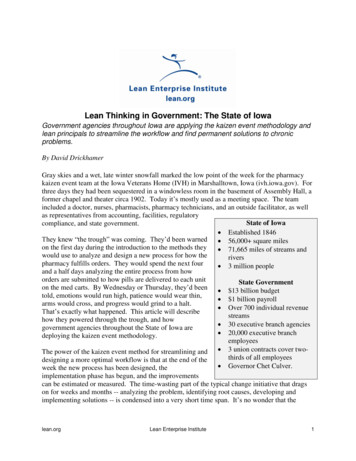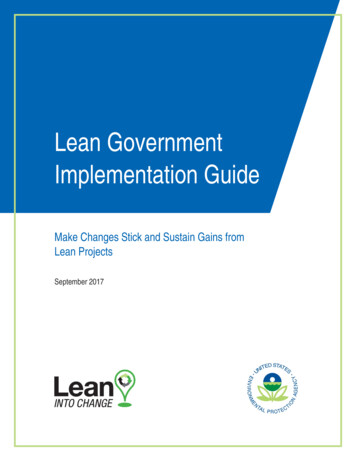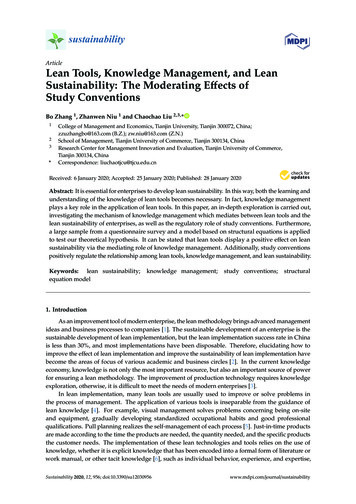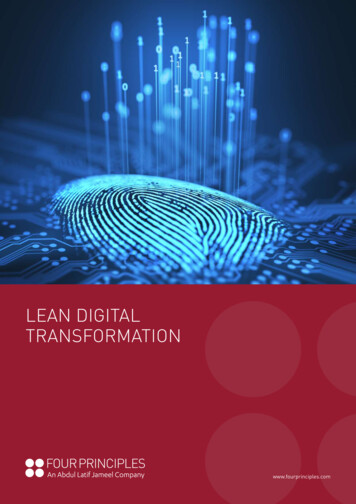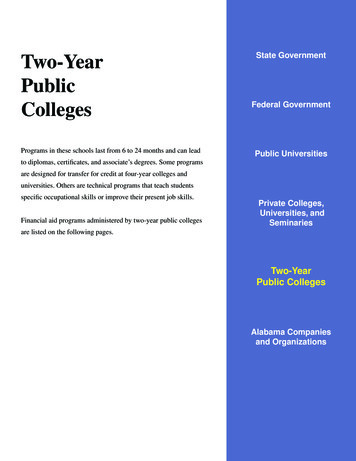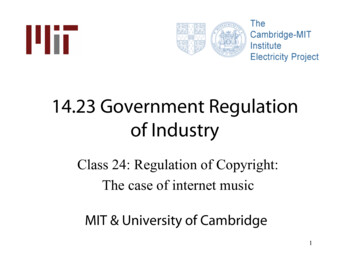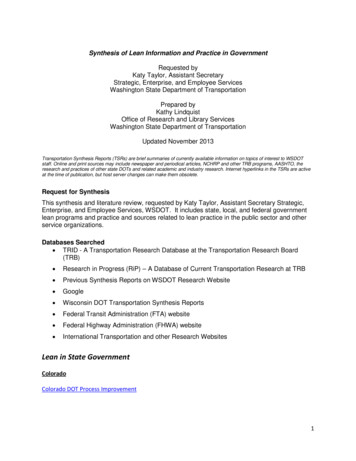
Transcription
Synthesis of Lean Information and Practice in GovernmentRequested byKaty Taylor, Assistant SecretaryStrategic, Enterprise, and Employee ServicesWashington State Department of TransportationPrepared byKathy LindquistOffice of Research and Library ServicesWashington State Department of TransportationUpdated November 2013Transportation Synthesis Reports (TSRs) are brief summaries of currently available information on topics of interest to WSDOTstaff. Online and print sources may include newspaper and periodical articles, NCHRP and other TRB programs, AASHTO, theresearch and practices of other state DOTs and related academic and industry research. Internet hyperlinks in the TSRs are activeat the time of publication, but host server changes can make them obsolete.Request for SynthesisThis synthesis and literature review, requested by Katy Taylor, Assistant Secretary Strategic,Enterprise, and Employee Services, WSDOT. It includes state, local, and federal governmentlean programs and practice and sources related to lean practice in the public sector and otherservice organizations.Databases Searched TRID - A Transportation Research Database at the Transportation Research Board(TRB) Research in Progress (RiP) – A Database of Current Transportation Research at TRB Previous Synthesis Reports on WSDOT Research Website Google Wisconsin DOT Transportation Synthesis Reports Federal Transit Administration (FTA) website Federal Highway Administration (FHWA) website International Transportation and other Research WebsitesLean in State GovernmentColoradoColorado DOT Process Improvement1
ConnecticutConnecticut Governors Redouble Commitment to Lean GovernmentIowaOffice of Lean EnterpriseLean is a collection of principles, methods and tools that improve the speed and efficiency of anyprocess by eliminating wasteLean Business Process Improvement in the Executive BranchResults of Lean Business Process Improvement in the Executive Branch of Iowa State GovernmentMarylandThe Maryland World Class Consortia and Lean GovernmentMaineBend the Curve Lean Initiative - making good headway with Lean in Maine on multiple frontsMinnesotaLean is a coordinated state government initiative for improving the organizational performance andresults.Lean Online 2010/2013 ResultsMinnesota Commission Calls for Expanding Lean DeploymentMinnesota State Services for the Blind Radically Improves ServiceMichiganMichigan Lean ConsortiaMichigan DOT 2013 System Performance Measures ReportNew HampshireLean New HampshireOhioLean Ohio is all about creating simpler, faster, and more cost-effective services through the use of Lean,Kaizen, and Six SigmaOregonGoing Lean in state government2
WashingtonResults Washington: About LeanLean Resources: Books, Websites and Blogs from Results WashingtonState of Washington: Review of Lean in GovernmentLean in the Federal GovernmentUS ArmyLean Six Sigma Read MoreEPAThe Lean in Government Starter Kit: How to Implement Successful Lean Initiatives at EnvironmentAgenciesLean in City GovernmentCape Coral, FL.The City has initiated a “Lean Government” program for simplifying and streamlining various businessprocesses.Grand Rapids, MI.Using Lean Thinking to Reinvent GovernmentJacksonville, FL.Jacksonville Lean ConsortiumJacksonville's Top Cop Wins a Third Term with LeanCounty of Ventura, CA.Applying Lean and Six Sigma since 2008 to improving Government processes and serviceBrown County, WIBrown County’s Lean ManagementLean in Government SourcesThe Guide to Lean Enablers for Managing Engineering ProgramsOilmen, Josef, (Ed.); the Guide to Lean Enablers for Managing Engineering Programs, Version 1.0.;Cambridge, MA: Joint MIT-PMI-INCOSE Community of Practice on Lean in Program Management; 2012.Summary: This guide provides findings of the joint MIT PMI INCOSE Lean in Program ManagementCommunity of Practice that are the based on a one year project during 2011-2012. Selected subjectmatter experts from industry, government, and academia participated. The findings are based on known3
best practices from the literature, program experience of the subject matter experts, and input from anextensive community of professionals. The findings were extensively validated through community andpractitioner feedback, multiple workshops at INCOSE and PMI conferences, LAI hosted web basedmeetings, and surveys of the extended professional community. The survey results clearly show thatprograms using the Lean Enablers show a significantly stronger performance in all dimensions—fromcost, to schedule and quality as a well as stakeholders’ satisfaction.The core of this document contains 1) the themes for major engineering program managementchallenges, and 2) the Lean Enablers along with 286 sub-enablers to overcome challenges, and betterintegrate program management, systems engineering and lead engineering programs to excellence. Themain engineering program management challenges identified and addressed by Lean Enablers in thisguide are reported in detail in Section 4 and summarized as follows:Major Challenge Themes in Engineering Programs that Lean Enablers Help to Address:1.Firefighting.—Reactive program execution2.Unstable, unclear, and incomplete requirements3.Insufficient alignment and coordination of the extended enterprise4.Processes are locally optimized and not integrated for the entire enterprise5.Unclear roles, responsibilities, and accountability6.Mismanagement of program culture, team competency, and knowledge7.Insufficient program planning8.Improper metrics, metric systems, and KPIs9.Lack of proactive program risk management10.Poor program acquisition and contracting practicesExtreme Government MakeoverBy Ken Miller; Governing.com; 2011The house of government is broken, and it needs a serious makeover from top to bottom. In his latestbook, management expert Ken Miller discusses how the processes of state and local governmentbecame so complicated and inefficient – and how to start cleaning up the mess. This book reveals thetips, strategies, and hiding-in-plain-sight secrets for making government work better.Lean GovernmentQPIC, LLC Lean Government Center; leangovcenter.com; 2011Summary: Lean focuses on what are the key processes in all agencies, what services are they delivering,and how much of what is being done is value-added (what the taxpayer truly needs and is willing to payfor) vs. non-value added. It’s not unusual to find improvement opportunities on the order of magnitudeof 50% where Lean is applied. Lean takes continuous improvement to the next step focusing onmeeting customer needs and performance metrics, along with organizational change.Lean is based on:The GoalTo deliver continuously improving value-added services (quality and speed of service) tocustomers (taxpayers) at lower costs.Process ImprovementTo be able to identify key processes, how they are performing, and apply Lean tools to makeimprovements in reducing costs/wastes and enhancing revenues.4
People are the BusinessThere needs to be a high respect for people. A constant search for how to improve things andreduce errors looking at the process and the non-valued added steps vs. who's responsible forthe error—and finding the lessons in every “failure.” Blame does not foster improvement orinnovation.Some Lean Government Metrics:Time Based: Lead Time - To Accomplish the Job% On Time DeliveryTotal Processing TimeValue Added TimeNon-Value Added TimeCost Based: Total Process CostLabor SavingsQuality Based: Customer SatisfactionRework Steps/TimeFirst Pass Yield - Done Right the First Time% Complete, Accurate, Zero DefectsProcess Based: # of Decisions Required# of Signatures Required# of Delays# of HandoffsOrganization Based: Employee SatisfactionTurnoverLean Events ConductedLean Event ParticipationLean Training ConductedLean and Fit: Improving Frontline Service in an Age of AusterityBy Geoff Gibbons, Andrew O’Brien, Alastair James, & Keith Leslie; Deloitte Co. UK; 2010Summary: This paper is aimed at Chief Executives to help in understanding the opportunity in using Leanprinciples to radically reshape public service delivery.Lean Six Sigma: Fad or Miracle Drug?By Jonathan D. Breul & John M. Kamensky; Governing.com; Sept. 15, 2010The process-improvement program has had success in Indiana and Louisiana.5
Lean Government Methods Guide EPAEPA; www.epa.gov/lean/government ; 2009Document Includes:Lean in Government Starter KitWorking Smart for Environmental Protection: Improving State Agency Processes with Lean and Six Sigma(Lean Government Primer)Lean in Air Permitting Guide: A Supplement to the Lean Government Starter KitResource Guide to Effective Utility Management and LeanLean Leadership Guide: Leading Process ExcellenceLean Government Event Scoping GuideLean Government Metrics GuideLean: Excellence in Government (Fact Sheet)Case Studies and other information about EPA and State Lean activities can be found at the EPA LeanGovernment Initiative websiteLean LegacyBy Jonathan Walters; Governing.com; August 31, 2009Iowa's experiment with charter agencies ended when Governor Tom Vilsack left office. But efficiencyefforts live on.Lean Government's Promise of Going 'Lean'By Ken Miller; Governing.com; May 21, 2009It's the latest, busiest trend in government management. Just don't call it a fad.Applying Lean in GovernmentTransforming Government Performance through Lean ManagementBy Biniam Gebre, Petter Hallman, Mark Minukas, Becca O’Brien; McKinsey Center for Government;December 2012Summary: Lean management creates systemic impact by changing how managers manage – with a focuson leadership skills, offering faster, scalable, and more durable improvements. Lean management helpspublic sector organizations streamline processes by addressing the causes of organizational inefficiency,building the management systems and capabilities to sustain new ways of working, and engagingeveryone in making continuous improvement a part of daily work.MCG Transforming through lean manageBuilding High Performance Government through Lean Six Sigma: A Leader's Guide to Creating Speed,Agility, EfficiencyBy Mark Price, Walter Mores, and Hundley M. Elliotte; Accenture; www.accenture.com; 2012Summary: This book highlights viable strategies in use today creating strategic alignment and greaterproductivity in government.6
Building a Culture of Innovation through Lean Six Sigma and Learning Organization PrinciplesUS Senate Productivity and Quality Award for VirginiaDan Stonecypher and Fred Salanitor, Norfolk Naval Shipyard; Forum for Excellence – Sept. 11, 2011,Richmond VA; 2012Summary: A PPP slide presentation on how the Norfolk Naval Shipyard built a culture of innovationusing Baldrige, Lean Six Sigma, and Learning Organization principles.Lean Continuous Improvement: Resource Management Agency Lean Deployment and ImplementationPlanVentura County, California; 2009Summary: This plan compliments the continuous improvement efforts already begun at the County, andthis Deployment and Implementation Plan describes an agency-wide approach to implementing Lean SixSigma. (See PDF)Ventura Co. LeanDeployment or ImplemLean Performance Management for Public SectorOracle White Paper; www.oracle.com; July 2009Summary: This White Paper on Lean Performance Management states that in the public sector,performance management should influence and inform outcome management by continuouslyoptimizing costs, quality, and customer service. (See PDF)lean-performance-management-wp-17171A Leaner Public SectorBy Maia Hansen and John Stoner; McKinsey on Government, Number 4; Summer2009Summary: The article describes how public sector organizations can improve performance usingelements of lean and Six Sigma incorporating both “soft” and the “hard” side aspects for long lastingorganizational change and improvement. (See PDF)TG MoG Issue4 lean[1].pdfEight Workable Strategies for Creating Lean GovernmentBy Chew Jian Chieh; Center for Organizational Effectiveness; 2008Summary: Lean government: The very idea sounds implausible. Governments’ traditionally are seen asguardians of red tape, incomprehensible forms, and endless queues. But, there are workable Leanstrategies for governments seeking to reduce waste and be efficient.Working Smart for Environmental Protection: Improving State Agency Processes with Lean and SixSigma7
Prepared by Ross & Associates Environmental Consulting; Lean in Government Series; National Centerfor Environmental Innovation; 2006Summary: Several state environmental agencies dramatically improved agency permitting andadministrative processes using Lean and Six Sigma process improvement methods. Within a few monthsof implementation, Delaware, Iowa, Michigan, Minnesota, and Nebraska drastically reduced permitapplication backlogs, reduced lead times for permit reviews by more than 50 percent, decreased thecomplexity of permit application forms, improved the consistency of permit reviews, and made morestaff time available for “mission critical” work—all while improving staff morale and transparency oftheir processes to stakeholders, without sacrificing environmental protection goals or reducing valueadded permit review time.Additional Sources on Implementing LeanThe Shingo Prize for Operational ExcellenceThe Shingo Model: The Shingo Principles of Operational Excellence – The Shingo TransformationalProcessSCOPE: The Shingo PrizeJon M. Huntsman School of Business; Utah State University; 2013Summary: The Shingo Prize for operational excellence is a not-for profit foundation located at UtahState University, named for Japanese industrial engineer, Dr. Shigeo Shingo, the renown thought leaderpioneering the concepts, management systems and improvement techniques known as the ToyotaBusiness System. The Shingo Prize is to create excellence across the entire organizational enterprisethrough the application of universally accepted principles of operational excellence, alignment ofmanagement systems, and the wise application of improvement techniques through teaching correctprinciples and new paradigms that accelerate the flow of value, align and empower people, andtransform organizational culture.Know What Counts. Measure What Matters. Deliver Results. Lean Six Sigma and the Quest forContinuous ImprovementXEROX; www.xerox.com; 2013Summary: A brochure providing examples continuous improvement projects at Xerox and other privateand public sector organizations using Lean Six Sigma principles.How to Identify and Select Lean Six Sigma Projects: Alignment with the Strategic PlanBy Douglas Mader, Quality Progress; www.qualityprogress.com; 2013Summary: Putting Best Practices to work in Strategic Planning using Lean Six Sigma requiresunderstanding of how to identify and select lean Six Sigma projects that are in alignment with theorganization’s strategic plan.Operationalize Your Strategic Plan Using Lean Six SigmaBy Donald D. Ainsworth; MetaOps Magazine; February 6, 2013Summary: This article describes using Lean Six Sigma in an organization to operationalize your strategicplan for successful strategy execution.8
Driving operational innovation using Lean Six SigmaBy George Byme, Dave Lubowe, and Amy Blitz; IBM Institute for Business Value – Strategy and Change;IBM; 2012Summary: CEO’s face mounting pressures to innovate; yet finding ways to actually enable innovationremains a challenge. Top companies with successful track records for innovation, have discovered onepossible solution. Expanding Lean Six Sigma, used in achieving operational excellence, can also do morethan improve processes. It can help leaders discover innovation opportunities far beyond operations,enhance financial performance and create organizations having an inherent inclination towardinnovation.Strategic Planning with Six Sigma and Lean: Choosing, Certifying, and ImplementingBaldrige.com; November 12, 2012Summary: This paper discusses the Strategic Planning portion of the Baldrige criteria specificallyaddressing how organizations approach process and performance improvement, emphasizing that longterm organizational sustainability, operational capability, and alignment are key strategic issues thatneed to be integral parts of an organization’s overall planning.Driving Operational Innovation Using Lean Six SigmaBy George Byrne, Dave Lubowe and Amy Blitz; IBM Institute for Business Value; 2012Summary: Lean Six Sigma, a relatively well-known approach for achieving operational excellence, inaddition to improving processes, can help leaders discover innovation opportunities far beyondoperations, enhance financial performance, and create organizations that have an inherent inclinationtoward innovation.Can Lean and Six Sigma Be Blended with Other Disciplines?By Paul Odomirak, MEd; The Possibility Press Thought Leadership Series; Transformation Systems, Inc.www.transformationsystems.com ; 2011Summary: This article describes different models that incorporate Lean Six Sigma, barriers toimplementation, and factors for success. Copyright 2011 by Paul Odomirak, M.Ed.Lean For Dummies Cheat Sheet - For DummiesBy Natalie J. Sayer, Bruce Williams; Wiley Company; 2010Summary: To understand how to apply Lean in any organization, you should know the basics: theprinciples, the definitions of value and waste, how to lead effectively, and how to define and improvethe value stream. You should also be aware of how a Lean leader thinks and acts.A Taxonomy of Lean Six Sigma Success Factors for Service OrganizationsBy Reza N. Hajikordestani, University of Florida, Master’s Degree Thesis; University of Central Florida,Orlando, FL; 2010Summary: This thesis reviews the concept of Lean thinking integrated with Lean Six Sigmaimplementation in service organizations and summarizes the success factors for successfulimplementation.Leading with Lean Six SigmaBy Thomas Pyzdek; PPP at 2009 ASQ Conference Proceedings, www.ASQ.org; www.Pyzdek.com ; 20099
Summary: This is a slide presentation that describes how to use Lean Six Sigma in strategic planning anddeveloping balance scorecards. Copyright 2009 by Thomas Pyzdek.Better Fostering Innovation: 9 Steps That Improve Lean Six SigmaForrest W. Breyfogle III, Business Performance Management, Best Practices for Finance Executives; 2008Summary: Lean Six Sigma brings rigor and discipline to project management, but its approach to projectselection is lacking. A new approach incorporates a structured, enterprise-level view of metrics to jumpstart corporate innovation.Getting the Right Things DoneBy Pascal Dennis, Lean Enterprise Institute, 2008Summary: In this book, Pascal Dennis outlines the basics of strategy deployment, answering two toughquestions that ultimately determine a company's lean transformation: What kind of planning system is required to inspire meaningful company-wide continuousimprovement? How might we change existing mental models that do not support a culture of continuousimprovement? How strategy deployment can help leaders harness the full power of Lean.Rapid Transformation: A 90-day Plan for Fast and Effective ChangeBehnam N. Tabrizi: Harvard Business School Publishing; 2007Summary: This book discusses the critical success factors differentiating successful organizationaltransformations from failed transformations. The most successful transformations are all-encompassing,integrative, fast, and have full, passionate commitment and buy-in at the top layers of the organization.Hoshin Kanri - The Strategic Approach to Continuous ImprovementBy David Hutchins; David Hutchins International Quality College; 2007Summary: This book describes the concept of Hoshin Kanri and underpins all of the leading Japanesebusiness strategies in companies such as Toyota, Honda, Komatsu, and many others and is viewedinternationally as the fundamental building blocks for a successful organization. David Hutchinsresearched Hoshin Kanri since its early development in the late 1960s and applied Hoshin Kanri withstunning success and summarizes his experience into this reference and guide.Strategic Deployment: How to Think Like ToyotaJill Jusko; Industry Week; October 15, 2007Summary: This article describes how using Hoshin planning provides organizations with a clear idea ofwhere they are going and how to get there.Lean Teams: Developing the Team-Based OrganizationThe Skills and Practices of High Performance Business TeamsBy Lawrence Miller; www.lmmiller.com ; 2005Summary: This paper defines a team-based organization, the what, and presents the transition processfrom a traditional organization to one built around high performance business teams—the how.10
Recent Books on Creating a Lean CultureToyota Culture: The Heart and Soul of the Toyota WayBy Jeffery Liker and Michael Hoseus, Center for Quality, People, and Organization; Copyright 2008McGraw HillWinner of the Shingo Prize for Research and Professional Publication in 2009, this book describesToyota’s continuous learning and improvement culture.A New Culture of Learning: Cultivating the Imagination for a World of Constant ChangeBy Douglas Thomas and John Seely Brown; Copyright 2011 Douglas Thomas and John Seely BrownThis book provides information on creating a culture of continuous learning.The Leader’s Guide to Radical Management: Reinventing the Workplace for the 21st CenturyBy Stephen Denning; Copyright 2010 by John Wiley and Sons, Published by Josey-Bass; 2010This book provides a comprehensive review of the principles and practices involved in reinventingmanagement to elicit constant learning and continuous innovation.11
Lean Continuous Improvement: Resource Management Agency Lean Deployment and Implementation Plan Ventura County, California; 2009 Summary: This plan compliments the continuous improvement efforts already begun at the County, and this Deployment and Implementation Plan describes an agency-wide ap

